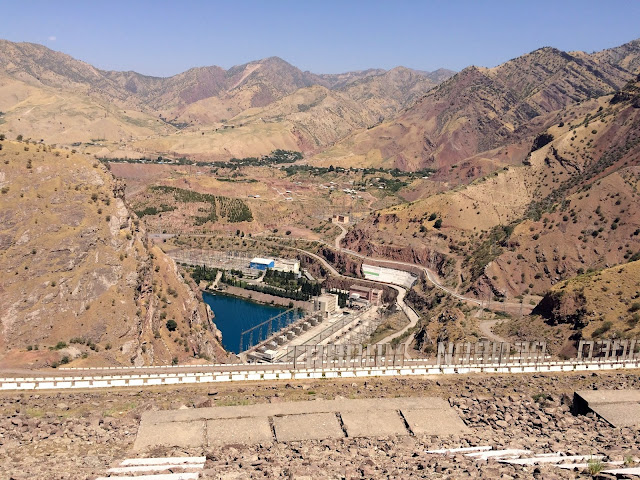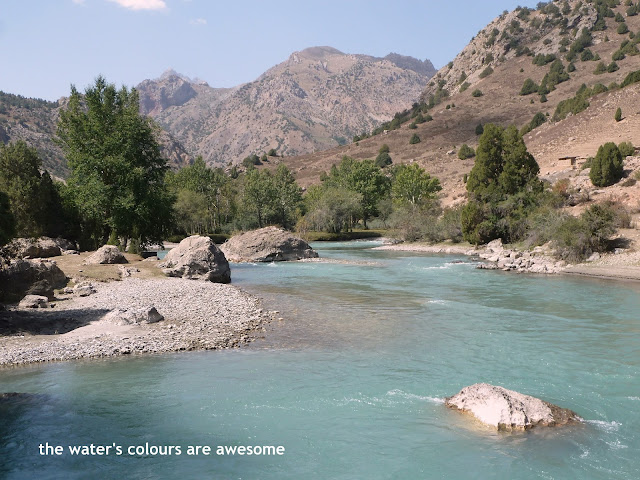 |
In Central
Asian countries like Tajikistan and Uzbekistan, which have long been under
Soviet rule or under Dictatorship and only now experiencing relative freedom,
there are occasions when you ask a question and there is no answer to your
query except for a shrug or a different answer.
Same applied
to our trip to the Nurek Dam. We were a few days early before we joined our
group across these two countries so as we had time to spare we took a trip to
see Nurek Dam, on the River Vaksh in Tajikistan. It is the largest earth filled
dam and the second tallest dam in the world. Begun in 1961, it was completed by
1980.
The Nurek
Dam was constructed by the Soviet Union and is uniquely constructed, with a
central core of cement forming an impermeable barrier within a 300 m
(980 ft)-high rock and earth fill construction. The volume of the mound is
54 million m³. The dam includes nine hydroelectric generating units,
the first commissioned in 1972 and the last in 1979
The dam is
located in a deep gorge along the Vaksh River in western Tajikistan, about
75 km (47 mi) east of the nation's capital of Dushanbe. There is a pleasant
tree lined township near the dam, also called Nurek, houses engineers and other
workers employed at the dam's power plant.
The reservoir
created by the dam is the largest reservoir in the country. It is a popular
weekend resort for the local population from around Dushanbe and this area. The
water fuels the hydro electric plant and is used for irrigation of around 700
sq kms of farmland – transported 14 kms through the Dangara irrigation tunnel.
 It took 90
mins. for us to travel the 60 kms from Dushanbe to Nurek. We had an excellent
guide with us who we pumped for information on the country. The drive there was
very pleasant – we crossed many kms of vineyards and en route we saw many stalls
selling different types of fruit. We bought some grapes from one of these
stalls. -
It took 90
mins. for us to travel the 60 kms from Dushanbe to Nurek. We had an excellent
guide with us who we pumped for information on the country. The drive there was
very pleasant – we crossed many kms of vineyards and en route we saw many stalls
selling different types of fruit. We bought some grapes from one of these
stalls. -
On arrival,
we could hear the roar of water before seeing it – it came from a rather large hole
in the dam wall – suddenly it just came – a huge wall of water nonstop. It seemed
they had opened some gates in the lake to let water go downhill. The water
colour was an unbelievable blue.
As courtesy
required and as per law, we stopped to meet the local cop in charge of the
security post. We found that the Army were not allowing any visitors as the
Chinese and Tajik ministers were visiting (were they ministers ? – I doubt it
as they came only in one car and no escorts) so we were told to go back. So, I
decided to play upon his ego and started speaking to the Major using my guide
as translator. We talked about him, his duties as a soldier, the duration of
being a way from family, the toughness of such isolation etc. We shared nuts
and grapes which we brought from the car. Eventually, he agreed that we could
park the car a bit far from direct view and he would let us know as soon as the
VIP’s went. Over an hour passed whilst we sat waiting. Well worth it.
We went
through a security gate and climbed right up to the top, 300 metres up. There is
an awesome view of the whole dam with the township below. There was just one
family in a Mercedes car which showed that this person had some clout to belong
up here at the top. The countryside is extremely hilly with grape vineyards
everywhere. We spent
some time on the dam site as well as surrounds before returning back to
Dushanbe.
Text and photographs copyright of the author. No part of this article or photographs maybe transmitted or reproduced by any means, electronic, mechanical, photocopying or otherwise, without written permission. Do contact the author on email -- helpthesun@gmail.com



































































